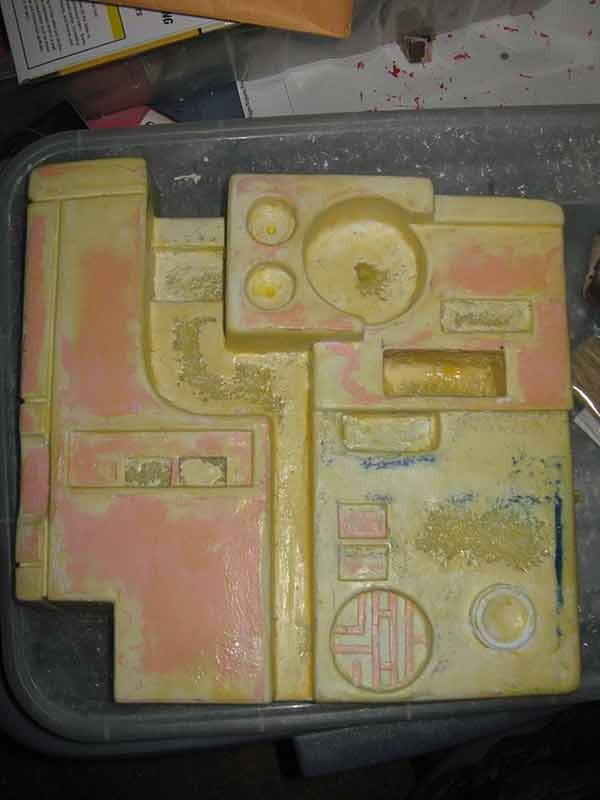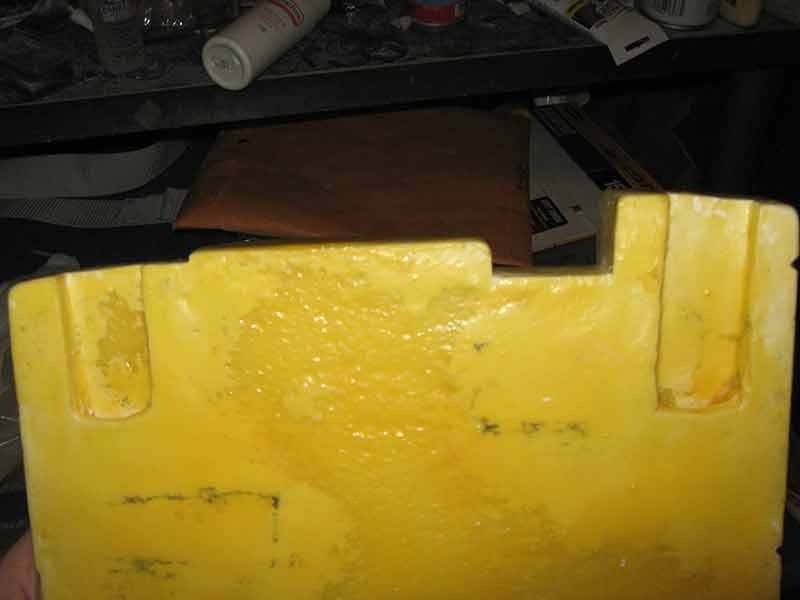Blue Leader
Sr Member
Greetings. I have a question regarding making a mold of a prop that I made, and then making some resin casts of it.
I've been watching videos and reading guides about making this because I've never done anything like this before, and while I think that I understand how to do it, before I order the silicone and resin I just wanted to make sure that what I'm understanding is correct. I'm just a little paranoid, I guess. Heh heh...
The chestbox pictured below is what I'm going to be making a mold of. Well, one of the things. I'm also working on a helmet (which is fairly small, actually) and there will be various greeblies, too, though I figured that the helmet mold could be made about the same way as the chestbox mold, and the greeblies would just have silicone poured over the top of them as a one-piece mold.

To make the mold, I was watching the video here from Tested, and it seemed like that would be a good way to do the chestbox and helmet. Following the video, I'd put clay halfway up the chestbox, line the clay with box walls of some sort, spray on some clear coat, and then pour the silicone on. After the silicone was dry, I'd rip apart the box, pull away the clay, flip the chestbox over so that the silicone side was on the table, rebuild the box, more clear coat, and pour on the other side of silicone. Does that sound correct? Also, I was wondering what type of silicone would be best for this? In the video they used Mold Star 20T from Smooth-On but I can't find that on the Smooth-On website... I also don't have access to a vacuum machine, or really any other type of machine besides rotary tools and small things like that, so that would be out of the question, though I don't know if it would be needed or not. I saw the OOMOO silicone that says it doesn't require vacuum degassing... Would that be a good silicone for me to purchase and use for this project? If so, which one would be best, OOMOO 25 or OOMOO 30? If not, which would be a better silicone for me to use?
To cast the props I was watching some videos, including this one, and thought that it looked simple enough. I thought that it would probably work fine for what I'm trying to cast, though I'd have a big block of silicone rubber mold rather than one more shaped to the piece... For the resin, like in the video, I'd use Smooth-On Smooth-Cast 65D... Pour some in to the open end of the mold, rotate it around for a while, let it set, pour in some more, rinse and repeat a few times until the thickness of the resin looks good. Does that sound about right? Is the Smooth-Cast 65D what I would want for this? I also noticed that for most of the Smooth-Cast resins the Smooth-On website says that a scale isn't required for mixing ratios of part A and B, but for Smooth-Cast 65D it doesn't say that... Is a scale required for getting the correct A and B ratios or is that just a fluke on the website?
And lastly, should I use a mold release before pouring the resin into the silicone mold? I know that it's usually a good idea for molding most objects, but when it comes to rotocasting (albeit by hand) I wasn't sure if I would still use a mold release or not, because I wasn't sure if the resin would be able to adhere well enough to the mold with it to take the shape of the prop or if the mold release would just make the resin pool at the bottom?
So, yeah, I think I get the gist of how to make these but I just wanted to make sure one more time before buying the resin and silicone. Any advice would be appreciated. Thank you!
I've been watching videos and reading guides about making this because I've never done anything like this before, and while I think that I understand how to do it, before I order the silicone and resin I just wanted to make sure that what I'm understanding is correct. I'm just a little paranoid, I guess. Heh heh...
The chestbox pictured below is what I'm going to be making a mold of. Well, one of the things. I'm also working on a helmet (which is fairly small, actually) and there will be various greeblies, too, though I figured that the helmet mold could be made about the same way as the chestbox mold, and the greeblies would just have silicone poured over the top of them as a one-piece mold.

To make the mold, I was watching the video here from Tested, and it seemed like that would be a good way to do the chestbox and helmet. Following the video, I'd put clay halfway up the chestbox, line the clay with box walls of some sort, spray on some clear coat, and then pour the silicone on. After the silicone was dry, I'd rip apart the box, pull away the clay, flip the chestbox over so that the silicone side was on the table, rebuild the box, more clear coat, and pour on the other side of silicone. Does that sound correct? Also, I was wondering what type of silicone would be best for this? In the video they used Mold Star 20T from Smooth-On but I can't find that on the Smooth-On website... I also don't have access to a vacuum machine, or really any other type of machine besides rotary tools and small things like that, so that would be out of the question, though I don't know if it would be needed or not. I saw the OOMOO silicone that says it doesn't require vacuum degassing... Would that be a good silicone for me to purchase and use for this project? If so, which one would be best, OOMOO 25 or OOMOO 30? If not, which would be a better silicone for me to use?
To cast the props I was watching some videos, including this one, and thought that it looked simple enough. I thought that it would probably work fine for what I'm trying to cast, though I'd have a big block of silicone rubber mold rather than one more shaped to the piece... For the resin, like in the video, I'd use Smooth-On Smooth-Cast 65D... Pour some in to the open end of the mold, rotate it around for a while, let it set, pour in some more, rinse and repeat a few times until the thickness of the resin looks good. Does that sound about right? Is the Smooth-Cast 65D what I would want for this? I also noticed that for most of the Smooth-Cast resins the Smooth-On website says that a scale isn't required for mixing ratios of part A and B, but for Smooth-Cast 65D it doesn't say that... Is a scale required for getting the correct A and B ratios or is that just a fluke on the website?
And lastly, should I use a mold release before pouring the resin into the silicone mold? I know that it's usually a good idea for molding most objects, but when it comes to rotocasting (albeit by hand) I wasn't sure if I would still use a mold release or not, because I wasn't sure if the resin would be able to adhere well enough to the mold with it to take the shape of the prop or if the mold release would just make the resin pool at the bottom?
So, yeah, I think I get the gist of how to make these but I just wanted to make sure one more time before buying the resin and silicone. Any advice would be appreciated. Thank you!

